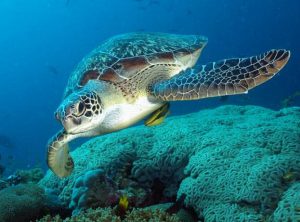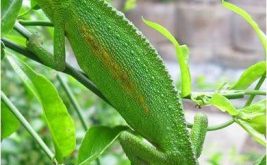Scientific name: Caretta caretta
Family: Cheloniidae
Description
The adult sea turtle is a reptile that weighs 80 to 200 kilograms and ranges in length from 70 to 95 centimeters. It is the second turtle in the world with the hardest shell. The head and shell have a yellow-orange or reddish-brown color, while the plate is usually pale yellow. The neck and sides of the turtle at the top are brown and yellow on the side and bottom. Adult male turtles are distinguished from females by having longer tails and claws, a smaller plate, wider and less vaulted shells, and usually wider heads. The sex is determined by the temperature of the underground nest. Eggs kept at a constant temperature of 32 ° C become female, those that are incubated at a temperature of 28 ° C become male, while a temperature of 30 ° C gives an equal number of females and males [4].
Habitat
Caretta caretta depends entirely on the land for its perpetuation, as this is where the spawning, hatching and subsequent entry of newborn turtles into the sea takes place [1]. More generally, however, they spend most of their lives in the open ocean and in shallow coastal waters, with rare land visits. It is found in the Atlantic, Pacific and Indian Oceans, as well as the Mediterranean Sea. It lives in water with temperatures at 27-28. C [4].
Reproduction
They mature sexually at the age of about 30, returning every two years to the place where they were born, to lay their eggs. In Cyprus they give birth on the beaches of Lara / Toxeftra, but her main breeding beaches are those of Polis / Limni in Chrysochous Bay [1,2]. They lay their eggs during the summer months, which they bury in the sand, near the water, and they hatch after two months. As soon as the newborns are hatch, which are about 100 in each nest, they all climb to the surface of the sand together, especially at night, and immediately run to the sea, guided by the reflection of the moon or stars on the surface of the water [1.4 ]. It has a low rate of reproduction, as after ovulation they cannot ovulate again for the next two to three years.
Protection
In the recent years, this turtle has been threatened with extinction [1,2], which is why it is protected by international conditions and organizations as well as environmental groups. There are also rescue centers for these turtles on our island. Although there has been a significant increase in the number of turtles in Cyprus in recent years, the existence of Caretta-Caretta is threatened by a variety of enemies, most notably humans. Some of these are the uncontrolled tourism development that degrades and destroys their breeding habitats, the noise from hotels and taverns, the disorientation of the newborn turtles, the use of non-selective fishing gear and the pollution of the seas.
Source:
[1] http://pafospress.com
[2] www.prasinipriza.com
[3] http://thalassiesxelones.blogspot.com/p/blog-page_815.html
[4] https://el.wikipedia.org/wiki/Caretta_caretta
Image source:
http://www.lgblog.gr/article/3822/gnorizontas-tin-kareta-kareta
 Κυπριακό Κέντρο Περιβαλλοντικής Έρευνας & Εκπαίδευσης – Κυκπεε
Κυπριακό Κέντρο Περιβαλλοντικής Έρευνας & Εκπαίδευσης – Κυκπεε




